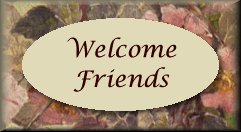 to
The Goblins, Elves and
Leprechauns Page
to
The Goblins, Elves and
Leprechauns Page
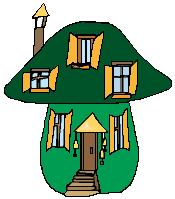 'Goblin' is another word for imp: a miniature,
mischievous devil while 'Elf'' is an old english word for 'Spirit'. Books,
myths and the folk tales of the mortal world state that Goblins and Elves
are supposed to be ugly, and hate human beings (according to folk tales
of).
'Goblin' is another word for imp: a miniature,
mischievous devil while 'Elf'' is an old english word for 'Spirit'. Books,
myths and the folk tales of the mortal world state that Goblins and Elves
are supposed to be ugly, and hate human beings (according to folk tales
of).
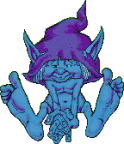 When a human baby is born, they try to steal
it and replace it with a child of their own: often called a changeling,
which then lives in the human world and makes mischief. Goblins and elves
like to play tricks on human beings. They turn milk sour, nibble cakes
left to cool and make wailing noises to scare people in bed at night.
When a human baby is born, they try to steal
it and replace it with a child of their own: often called a changeling,
which then lives in the human world and makes mischief. Goblins and elves
like to play tricks on human beings. They turn milk sour, nibble cakes
left to cool and make wailing noises to scare people in bed at night.
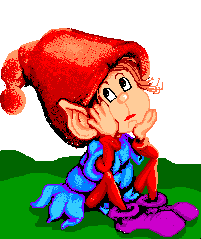 But all this is what is usually said, but you
know what?? Its not true at all, actually elves are very cute beings almost
like a fairy but a little bit naughty and they DO play tricks which can
be irritating sometimes but they are not evil.
But all this is what is usually said, but you
know what?? Its not true at all, actually elves are very cute beings almost
like a fairy but a little bit naughty and they DO play tricks which can
be irritating sometimes but they are not evil.
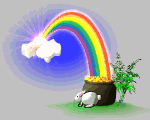 Leprechauns come from Ireland. They are shoe-maker
elves. They bury gold in holes, and mark the place with a rainbow; where
the rainbow ends, there is the gold. Anyone who manages to catch a leprechaun,
and hold it still, can make it lead the way to the rainbow's end and so
to the treasure. But Leprechauns are much cleverer than the mortals. No
human being has ever managed to find a Leprechaun's pot of gold yet (except
in stories).
Leprechauns come from Ireland. They are shoe-maker
elves. They bury gold in holes, and mark the place with a rainbow; where
the rainbow ends, there is the gold. Anyone who manages to catch a leprechaun,
and hold it still, can make it lead the way to the rainbow's end and so
to the treasure. But Leprechauns are much cleverer than the mortals. No
human being has ever managed to find a Leprechaun's pot of gold yet (except
in stories).
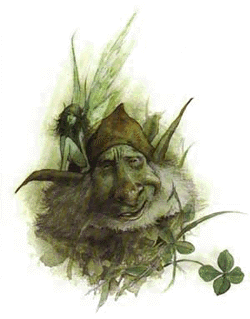 Ah, and we mustn't forget about the four-leaved
clover, which is believed to bring good luck to the person who finds it
(clovers usually have three leaves). So, if you happen to see/find
a Leprechaun, catch him, hold him tightly and don't let go, he may lead
you to his pot of Gold to get rid of you and escape BUT Beware, he may
be cunning enough to get the pot back as well as escape.
Ah, and we mustn't forget about the four-leaved
clover, which is believed to bring good luck to the person who finds it
(clovers usually have three leaves). So, if you happen to see/find
a Leprechaun, catch him, hold him tightly and don't let go, he may lead
you to his pot of Gold to get rid of you and escape BUT Beware, he may
be cunning enough to get the pot back as well as escape.
Happy Hunting :)
 Select the Page
you wish to visit next ...
Background set & mushroom
cottage by
Select the Page
you wish to visit next ...
Background set & mushroom
cottage by
 All the content unless
specified is © Nazish 1999.
Do not use anything from
this site without the author's expressed written consent.
All the content unless
specified is © Nazish 1999.
Do not use anything from
this site without the author's expressed written consent.
















